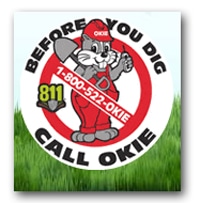Okie One-Call Now to Include Watershed Flood Control Dams

The Oklahoma Conservation Commission (OCC) now has an agreement in place with the Okie One-Call System to include all Watershed Flood Control Program dams in Oklahoma, with conservation districts as the Okie One-Call points of contact.
Oklahoma One-Call System, Inc., is a non-profit organization incorporated in 1979. It is a communication link between the excavators and operators of underground facilities to help prevent damages to public services. The Call-Okie program is designed to promote public awareness and to eliminate potential hazards posed to excavators, the general public, vital underground facilities and the environment when excavation is done.
Beginning in June 2010, conservation districts with watershed dams will begin receiving “Locate Tickets” by email for any excavation that is going to occur within one-half mile of the watershed dam. Districts will have 48 hours to “locate” the watershed dam for the excavator prior to the start of excavation. Districts should review the Locate
Ticket thoroughly and contact the excavator to alert them of the watershed dam and the existence of an easement.
“Getting watershed dams and associated conservation districts on the Okie One-Call System is a tremendous achievement,” said Mike Thralls, OCC executive director. “It positions districts to be proactive in addressing any and all potential hazards to the watershed dam before excavation occurs,” Thralls said.
In previous years the cost of adding the state’s watershed dams into the Okie One-Call system would have been exorbitant because of the need to manually enter legal descriptions for each one of the more than 2,100 dams in the state. But with the advent of Global Positioning Systems (GPS) for identifying locations and Geographic Information Systems databases for storing the location information, the cost is greatly reduced.
“Being able to load our GIS database of locations for every watershed dam in the state made the effort very cost-effective and very efficient. We must also commend Okie One-Call for establishing a feasible membership rate for government entities and recognizing conservation districts as subdivisions of state government,” said Robert Toole, director of OCC’s Conservation Programs division.
When a conservation district receives a Locate Ticket, a district representative will examine the location of the proposed excavation site in relation to the entire easement of the watershed dam including the land that is only underwater during flood events – the flood pool. The representative will determine not only possible impacts to the current operation and maintenance of the flood control dam, but also possible impacts should the dam be rehabilitated in the future. The need for dam rehabilitation often results from a raised hazard rating for a dam because of new residential or business development downstream, and commonly calls for increasing the height and spread of the dam to increase the flood storage capacity. If the conservation district representative determines that the excavation or future location of the proposed installation could impact the watershed dam or appurtenances, he or she will contact the contractor and arrange for an on-site consultation.
“Even if there is no impact indicated, it would still be a good practice for the conservation district to meet with the contractor to educate them about watershed dams and watershed easements,” Toole said.
